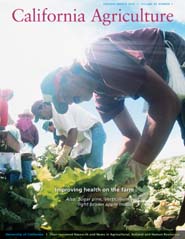All Issues

Improving health on the farm
Cover:
California has about 1 million farmworkers and farm family members, who face unique health and safety risks. Air particulate levels in the Central Valley are among the nation's highest (see page 12), and California Latinos may be at increased risk of diabetes (see page 17). (Photo of farmworkers harvesting lettuce in Five Points, Calif., by Andy Sacks.)
January-March 2010
Volume 64, Number 1
Volume 64, Number 1
News and opinion
General Information
LETTER
Letters: January-March 2010





